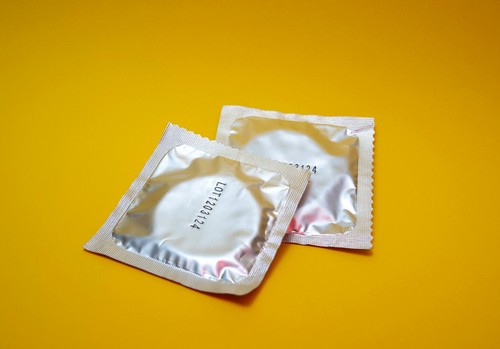What is Precum and Can it Get You Pregnant?
Ever wondered how likely it is to get pregnant from precum? Learn what precum actually is and if precum can cause pregnancy with Lovehoney.
When it comes to sex and getting pregnant, many people wonder, “Can you get pregnant from precum?”. The simple answer is yes.
Yet, many of us don’t know what precum actually is, what causes it, when it happens, does precum have sperm in it, and most importantly how to protect yourself or your partner from getting pregnant.
Read on to find the answer to all those questions, plus all the most popular types of birth control that people can use to avoid pregnancy, including the ever-popular pull-out method.
What is precum and when does it occur?

Precum (also spelled pre-cum or called pre-ejaculate), is a small amount of fluid that is released from the penis.
What does pre cum look like? Precum is a mucus-like, viscous fluid that is slightly sticky.
What color is pre cum? Pre-ejaculation fluid is clear to whitish in color, much like ejaculation fluid, or regular cum.
When does precum occur? Precum happens just before ejaculation. It is produced by small glands in the penis called the Cowper’s glands and is an alkaline fluid that acts as a natural lubricant. The purpose of precum is to neutralize the acid in the urethra caused by urine, protecting the passage of the sperm as it flows through.
Do all men precum?
According to HealthTap, Dr. Harold Tsai says, yes. “All men secrete a clear fluid prior to ejaculating.” Other sources note that most penis owners produce a small amount of precum, from a couple of drops to up to a teaspoon. In some cases, much more fluid is produced, but this is rare.
What causes precum?
Some penis owners produce more pre-ejaculate than others. This is controlled by a range of factors, from your arousal level to hydration, and even certain medications you may be taking at the time. For more information on how medications may affect your sex life, see our article Having a Healthy Sex Life on Antidepressants.
Does precum have sperm in it?
Another common question many people have that can be rather confusing is “Does precum have sperm cells in it?”.
Again, the answer to this is yes. While precum doesn’t always have sperm in it, lingering sperm from the previous ejaculation can mix with pre-cum later on while having sex. This is because a small amount of semen may linger in the urethra after you ejaculate.
Some urban myths have suggested that urinating before sex will remove the sperm in the precum and clean out the urethra. This, however, is NOT the case, and one study has shown that “some men repeatedly leak sperm in their pre-ejaculatory fluid” even after urinating.
That same study found that 41% of penis owners have sperm in their pre-cum fluid, which is a very high percentage of men. And, while some men never have sperm in their precum, many men always do. In other words, if you do have sperm in your pre-ejaculate once, then you always do.
So can precum cause pregnancy?
The obvious question then now is “Can pre cum get you pregnant?”. Yes, it can.
If 41% of penis owners have sperm in their precum, those sperm can (and often do) fertilize an egg, which can lead to pregnancy. Therefore the risk of pregnancy even when you don’t ejaculate into your partner is reasonably high if you are one of the 41% who produces sperm in your precum every time. And since there is no way to know whether your precum contains sperm in it or not, it is certainly possible to get pregnant from pre-ejaculation.
How likely is it to get pregnant from precum?
Good question! While some sources say the chances are fairly low, it depends on what method of birth control you are using at the time. If you are using the pull-out method, the American College of Obstetricians and Gynecologists, says that “22 out of 100 women using this method will become pregnant in the first year”. That’s approximately 1 in 5 women who get pregnant every year using the withdrawal method of birth control.
Can you stop precum?
Many penis owners also wonder “How to stop precum?”. The truth is you can’t. The discharge of precum is a normal involuntary response when you become aroused. In other words, you can’t control it. And even if your partner is not ovulating at the time of sexual intercourse, sperm can live in the womb for several days. Thus there is still a slight chance that she can get pregnant.
However, while you can’t control when you pre-ejaculate, how much, or if there will be sperm in it, you can choose various contraceptive methods to help minimize the risk of pregnancy.
Here are the most popular and effective methods to prevent pregnancy during sex.
Contraception options
There are many contraceptive options available today that can help limit the risk of getting pregnant.
This article will investigate the various non-hormonal methods you can use, as well as which ones are the best. We will explore the use of condoms, the pull-out method, emergency contraception, and tracking your menstrual cycle.
Although it’s helpful to know the effectiveness of any particular birth control, a double barrier, meaning using more than one method, will be even more effective.
If you are interested in learning more about hormonal methods of contraception such as birth control pills and IUDs, please contact your healthcare provider to discuss the various options.
Pull-out method

What is the withdrawal or pull-out method?
The pull-out method of contraception, also known by its scientific term, “coitus interruptus”, is a popular form of birth control used by many couples. Approximately 59% of women, aged 15-44 in the US, have used the pull-out method at some time, with 4.6% using withdrawal as their primary method of contraceptive use. An additional 4.4% of women have used the pull-out method with another type of birth control, such as a condom.
How to do the pull-out method
In basic terms, the penis owner removes their penis from the vagina just before they come. This method works by keeping semen from the ejaculation out of the vagina, but it can be very tricky to do right.
Pros:
The withdrawal method requires no pre-planning.
It is free and readily available.
It can be effective when used with a condom.
It is better than not using any method at all.
Cons:
You must time the pull-out at the exact moment before any semen comes out.
It must be done correctly, every single time, which requires a high degree of self-control.
Sometimes it is hard to tell when you are about to ejaculate until it’s too late
To work, you also must ejaculate away from your partner’s vulva. Even a little bit of sperm can create a risk of pregnancy.
Precum, as we have found out, may still contain semen in it, so pull-out may not be effective in those cases.
Accidents can happen. So, the pull-out method is not as effective as other types of birth control, including using a condom or the pill.
It is also important to note that pulling out doesn’t protect one from STIs.
Is the pull-out method effective for preventing pregnancy?
No. As we have already learned, 1 in 5 couples who use this method will still get pregnant. So it is not considered an effective form of birth control, and in fact is one of the least reliable methods.
Emergency contraception

What is emergency contraception?
Emergency contraception is a pill or another form of contraception that is used to prevent pregnancy after having unprotected sex. It comes in two forms:
Emergency contraception is a pill or another form of contraception that is used to prevent pregnancy after having unprotected sex. It comes in two forms:
There are two types of morning-after pills:
A pill with ulipristal acetate, of which there is only one brand, Ella, which is only available by prescription and can be taken up to 120 hours (5 days) after unprotected sex (although it’s recommended to take this as soon as you can).
A pill with levonorgestrel. Brand names include Plan B, One Step, Take Action, My Way, Option 2, Preventeza, AfterPill, My Choice, and others. These types of morning after pills work best when you take them 72 hours (3 days) after unprotected sex, but you can take them up to 5 days after.
Pros:
- According to most sources, the morning-after pill is safe and effective in preventing pregnancy if used within 3-5 days after having unprotected sex.
- Anyone can get them regardless of age or gender.
- You can purchase a pill with levonorgestrel over the counter at a pharmacy without a prescription, or via a prescription from your doctor behind the counter.
- You don’t have to show your ID to get them.
- Some places, like Planned Parenthood, as well as family planning and health clinics, give them out for free or charge much less.
- Many health insurance plans help pay for emergency contraception.
- They are safe to use without side effects.
- They are most effective the sooner you take them.
- They are better than taking nothing at all.
Cons:
- Morning-after pills are not as effective during the two days that you are ovulating.
- Most types of the morning-after pill are not as effective as other forms of birth control, including condoms, the pill, and IUDs (intrauterine devices, or “coils”).
- Their effectiveness is based on where you are at in your cycle, so you need to track your cycle to know which one(s) to take.
- They are more effective if you act quickly - take them right after you have unprotected sex.
- Depending on your weight, either type of morning-after pill may be less effective or not work at all. If you weigh 195 pounds or more, the ulipristal acetate (Ella) may work less well. If you weigh more than 165 pounds, levonorgestrel morning-after pills may not work.
- They are more expensive than other types of contraceptives.
To learn more about the morning-after pill and other forms of emergency contraceptive (EC), see this resource at Planned Parenthood.
Tracking your cycle

Tracking your cycle (also known as the rhythm method, fertility awareness, and natural family planning) is one of the oldest methods of birth control, where a woman tracks her period (ovulation) as a form of contraception. Knowing when you ovulate helps you figure out when you are most and least fertile during your monthly moon cycle. The days nearest your ovulation are your most fertile days, so people either avoid sex on those days or use other forms of contraception.
There are three fertility awareness methods (FAMs) that people can use to figure out their cycle. These include:
- Charting your moon cycle on a monthly calendar.
- Taking your temperature each morning before getting out of bed.
- And checking your vaginal discharge every day.
Pros:
- It is a no-cost and easily available method.
Cons:
- According to Planned Parenthood FAMs are 76-88% effective. So almost 1 in 4 people will get pregnant using this method.
- They are difficult to use or remember to do.
- Most people need help from an expert to learn how to use them correctly.
- They are time-consuming.
- There are a few days a month that you can’t have sex unless you use other forms of contraceptives.
Want to enjoy sex on your period? Check out our blog article on Everything You Need to Know About Period Sex and Your Cycle for exciting tips!
Condoms

Condoms are a very effective form of birth control, and they also protect against STIs.
There are two types of condoms. The male condom fits over the penis, and the female condom, which is inserted into the vagina. For this article, we are focusing on male condoms as they are the most readily available on the market today and the most widely used form of birth control.
The male condom is rolled over the penis before penetrative sex. It collects your ejaculation when you come. This prevents sperm from entering the vagina. There are several different types of male condoms. Check out our Beginner’s Guide to Condoms to learn about all the types.
Pros:
- 98% effective, which makes them one of the most effective birth control methods.
- More effective than the rhythm method, FAMs, and the withdrawal method.
- Condoms are the only type of birth control that also protects from STIs.
Cons:
- Oil-based lubes can’t be used with latex condoms as they will break down the latex.
- Some people have latex allergies.
- Lambskin-type condoms don’t protect against STIs.
- Condoms can occasionally break if they are too small or put on the wrong way.
- If too large, a condom can slip off during sex. Therefore, having a proper fit is essential when using condoms.
- Because condoms are often not used properly IRL, they are only 85% effective. So make sure you are using them correctly!
- You have to remember to have a condom with you at all times.
- Some people don’t like the feel of a condom.
Check out our How to Use a Condom guide to learn how to use one properly.
Most Effective Forms of Birth Control
?w=500)
Here is a list of the most effective forms of birth control in percentages from Planned Parenthood to help you decide which type is best for you.
- Abstinence or Outercourse—100% Effective.
- Birth Control Implant—99% Effective.
- IUD—99% Effective.
- Female Sterilization—99% Effective.
- Male Vasectomy—99% Effective.
- Male Condoms—98% Effective.
- Breastfeeding Method—98% Effective.
- Birth Control Shot—94% Effective.
- Birth Control Vaginal Ring—91% Effective.
- Birth Control Patch—91% Effective.
- Birth Control Pill—91% Effective.
- Diaphragm—88% Effective.
- Female Condoms—79% Effective.
- Birth Control Sponge—76-88% Effective.
- Fertility Awareness Methods—76-88% Effective.
- Withdrawal Method—78% Effective.
- Spermicide & Gel—72 or 86% Effective.
- Cervical Cap—71-86% Effective.


